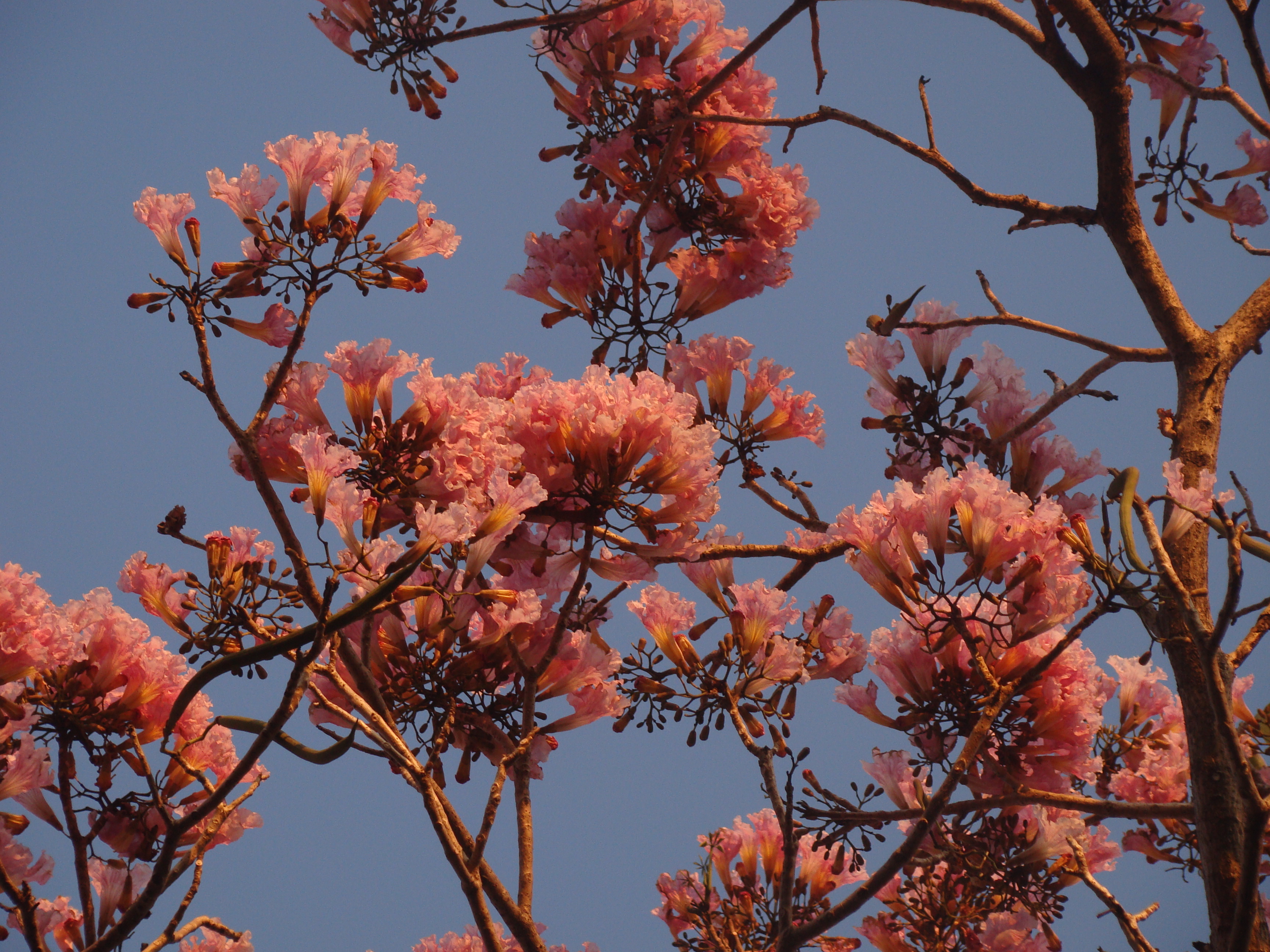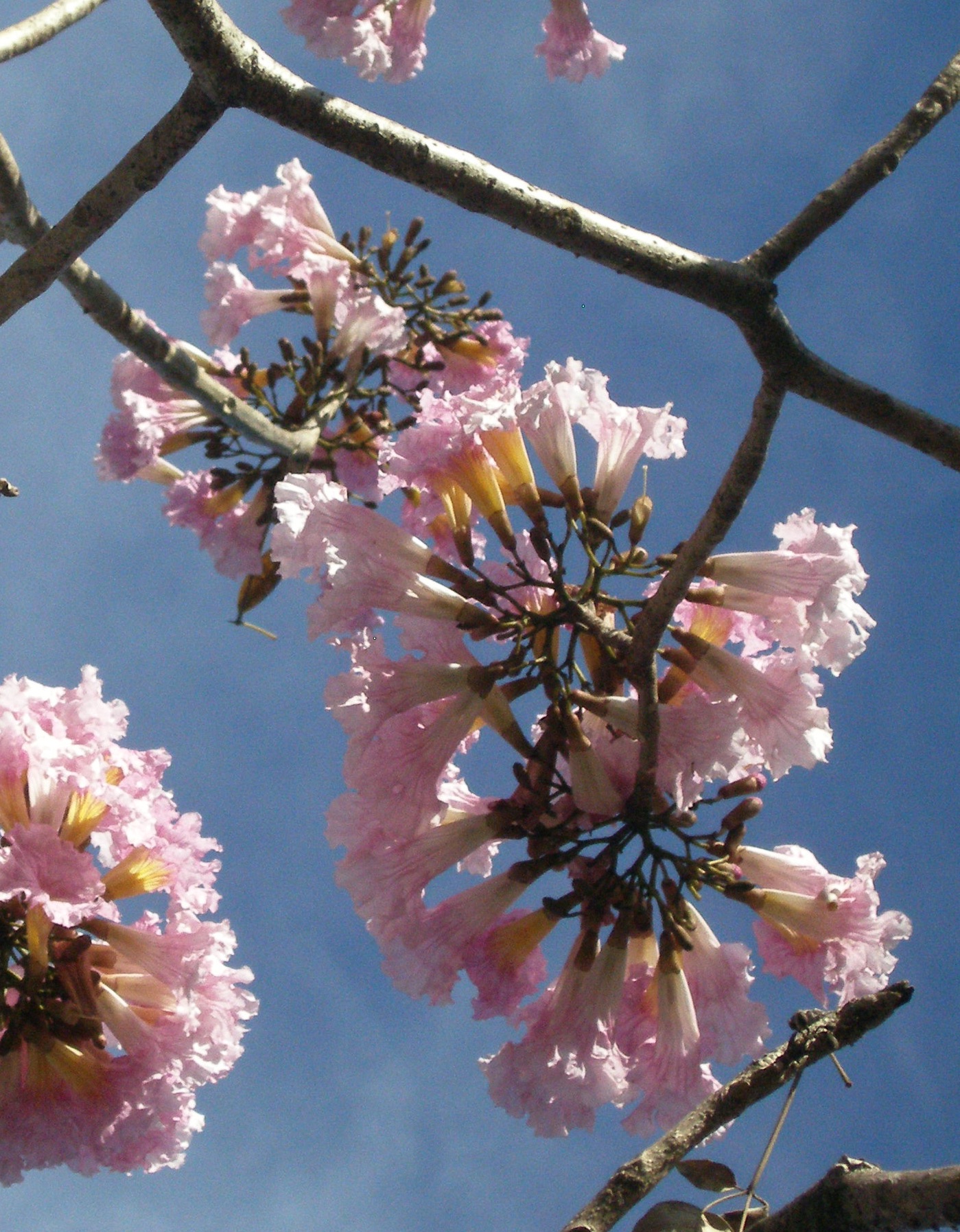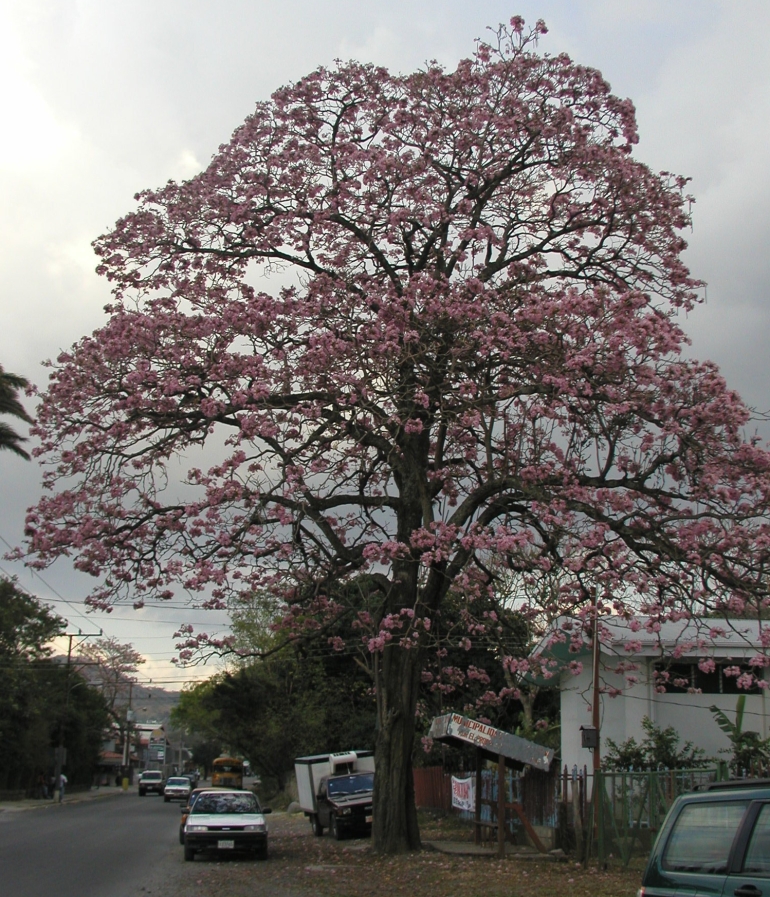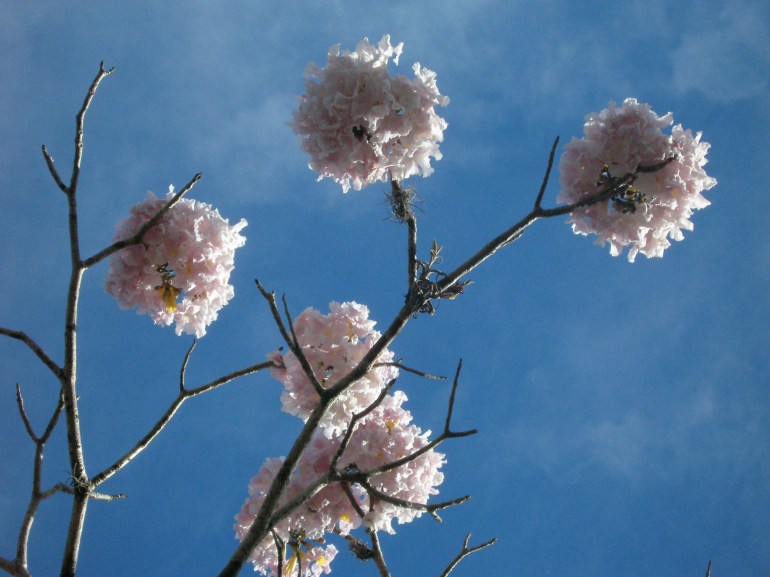Tabebuia rosea (Vertol.) DC.
Bignoniaceae ROBLE DE SABANA, TRUMPET TREE
Tree: Common deciduous sub-canopy or canopy tree (20-30 m) found preferentially on well to excessively drained soils such as those present along the sandy coast. Roble de Sabana is an especially notable tree thanks to the often spectacular displays of pink blossoms that it produces during the height of the dry season. This species shares much of its range with the Corteza tree (Tabebuia chrysantha), a close relative whose similar – though more ephemeral – shows of large yellow flowers are truly breathtaking. Roble is the national tree of El Salvador.
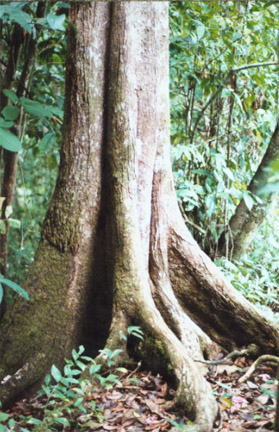
Description: Roble de Sabana has a mostly regular, straight, and cylindrical trunk that may reach 70 cm or more in diameter. Large, rounded folds appear in the bole near its base and these form stout but short buttress roots at ground level. Roble bark is light gray or tan colored and, in young trees, is marked by fine, vertical cracking. Older individuals often have much thicker and rougher bark that is shallowly etched by wide, vertical fissures. With stout, often angular limbs that subdivide into a moderate number of stubby twigs, Roble has a thin, single-layered crown that tends to be tall and relatively narrow in shape. Roble foliage is unique and serves as an ideal characteristic for identification purposes. Leaves are palmately compound (25-35 cm in length) and oppositely arranged along the twig. Each is composed of a long petiole (13 cm) supporting five, smooth, elliptical leaflets of varying size: the three distal leaflets (25 cm by 8 cm on 5 cm petioles) being about twice the size of the proximal two (12 cm by 6 cm on 1 cm petioles). The overall asymmetrical pattern produced by this leaflet configuration (shared by all members of the Tabebuia genus) is memorable, making this species easy to recognize. All foliage is shed at the start of the dry season in late December and January and the trees remain bare until late April when the first individuals begin to bud. Re-foliation is complete by June. (The exact timing of these events is strongly influenced by the microclimate experienced by individual trees, with those found in wetter depressions or near streams retaining their leaves longer into the dry season and being the last to regenerate them.)
Flowers (8 cm by 7 cm) are produced in large, terminal panicles during the dry season. Ranging in color from pink to white, each is dominated by a showy, trumpet-shaped corolla that is formed from the five fused petals. Five stamens and a central pistil adorn the blossom’s yellow center and the whole structure is supported by a cup-shaped, velvety-brown calyx. Flowers are observable from late January through late April, however there is often a very marked, dramatic, and highly synchronized flowering peak that occurs in February. During this peak, the trees – already leafless – are transformed into solid masses of pink blossoms. Seen against the backdrop of the deep blue, dry-season sky, this is a spectacular event – and one of the finest displays of color that the tropical forest has to offer. Like most things worth seeing, this spike in activity is short lived, lasting only three or four days. When in flower, individual Roble trees can easily be identified from a distance, brightly dotting the forest with their canopies of pink.
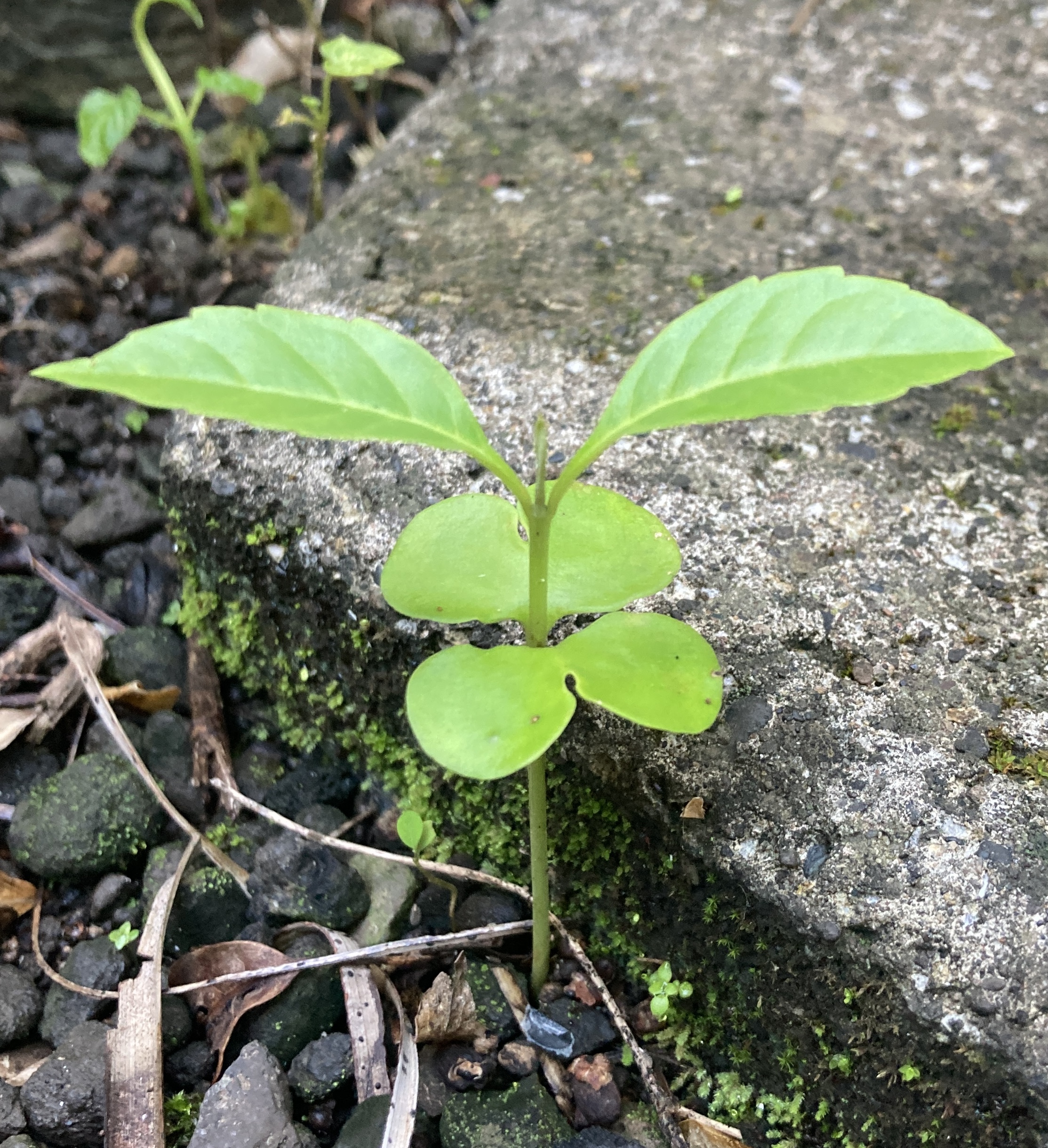
Fruits begin to grow immediately after the perianths are shed, reaching full size within a couple of weeks. They are long (30 cm or more), cylindrical, green or brown capsules that can be seen hanging vertically from the ends of the branches. After a month or two spent maturing and drying in the hot summer sun, these capsules split along two longitudinal seams that run down the sides of the pod. When this happens, hundreds of neatly-packed, doubly-winged and very flat seeds (3-4 cm long) are exposed. Seed wings angle outwards in precise columns on both sides of the pod, and the whole structure takes on a herring-bone pattern. Thus prone to the wind, the samaras are eventually plucked from the pods and begin a spinning decent – usually traveling some distance before settling on the forest floor. Harvests occur from March through May. Seed germination coincides with the advent of the rainy season in late April. By June, thousands of small seedlings – consisting only of a pair of lobed cotyledons – blanket the forest floor. These young trees grow rapidly at first, but most succumb to the drought induced by the following dry season. Should they survive, seedlings may be 15 cm tall by the end of their first year.
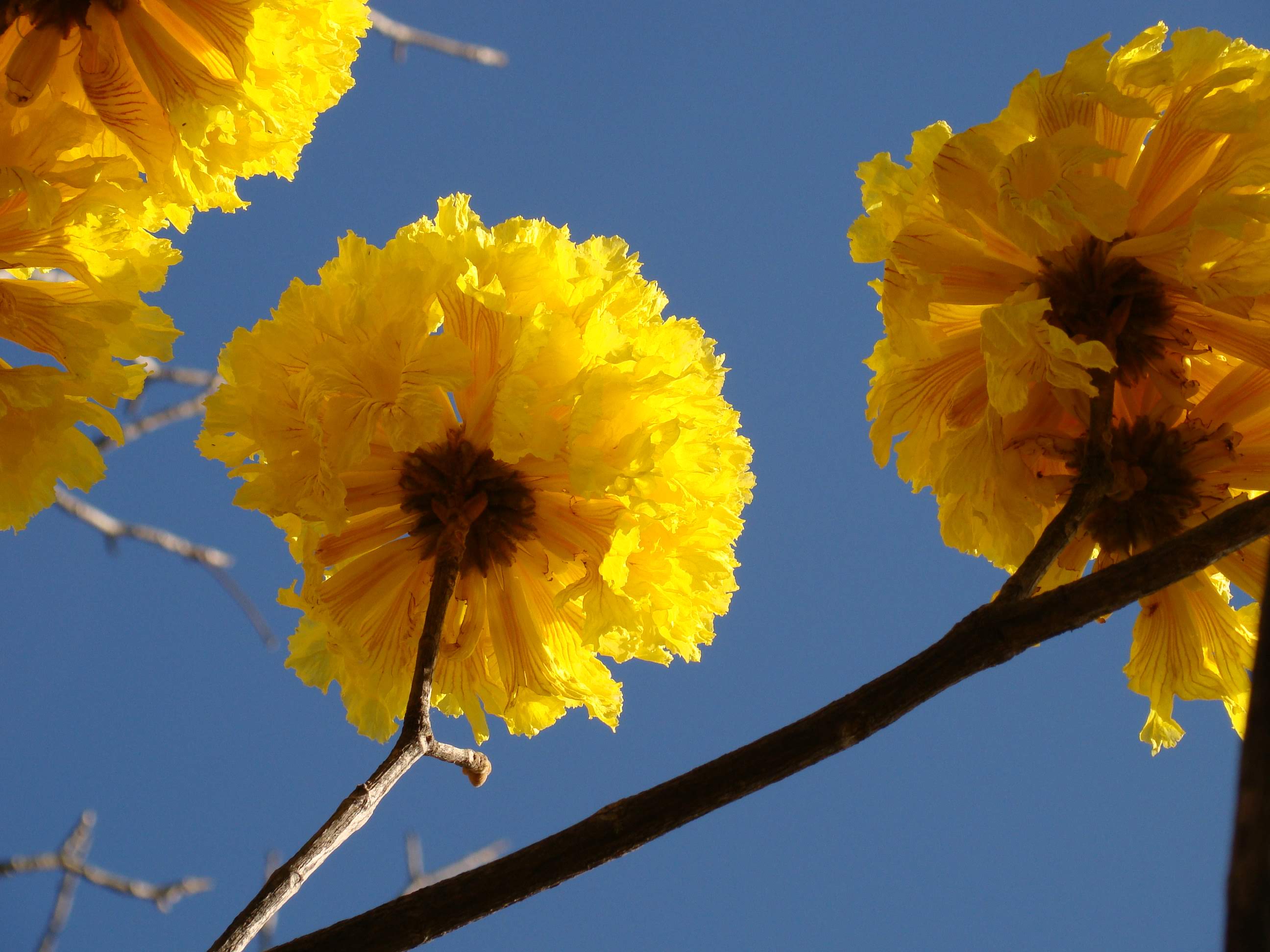
Similar Species: The asymmetrical leaf pattern produced by Roble’s five unequal leaflets is uniquely characteristic of, and common to, all of the five or so species of Tabebuia that are found in Costa Rica. Roble de Sabana is the only member of this genus present in Manuel Antonio, so there should be no difficulty in identifying it here. The stunning, yellow-flowered Corteza tree (Tabebuia chrysantha, see photo) coexists with Roble in many other, mostly drier, Costa Rican landscapes. Corteza can be distinguished from Roble by noting the large quantity of rufous hairs that cover the foliage, petioles, and young shoots of this former species.
Natural History: The timing and sequence of the fertility cycle demonstrated by Roble is common to a number of tropical forest trees that grow in regions with short but pronounced dry seasons. Flowers are often delicate structures that deteriorate rapidly in the presence of rain and wind. Large, showy blossoms, like those of Roble, suffer the most under these conditions. By timing its flowering period to coincide with the dry summer months, the Roble tree is demonstrating a behavioral adaptation intended to maximize blossom life and help ensure pollination. Furthermore, producing copious amounts of flowers at a time when obscuring foliage has been shed enhances their visibility – increasing the chances that pollinators (in this case mostly bees) will locate them.
The dry summer season is also the most appropriate fruiting period for a species that relies on the wind to disperse its seeds. Pods dry well in the hot sun and the winged or cottony seeds are kept light and buoyant by the arid conditions. Stiff summer breezes then serve to carry the seeds great distances away from the parent trees. Rainy weather would only serve to add weight to such seeds and they would be pulled to the forest floor – through the stagnant, wet-season air – with only minimal dispersal.
By the time fruition is complete and the seeds have been placed in the soil, the dry season is nearly over. The first rains then stimulate rapid germination and the young seedlings that emerge are provided with a maximum amount of time get established before the onset of the next dry season.
Roble’s habit of disseminating large quantities of relatively small seeds is representative of a general reproductive strategy shared by many other forest species (see introduction). All plant seeds contain similarly sized, tiny embryos accompanied by widely varying amounts of stored food. The most important characteristic in determining seed size, stored food is vitally important to the embryo, since it represents the seedlings single source of nourishment in the early days of its growth. Once this store is exhausted, the rapid growth typical of germination ceases, and the plant begins the slower process of providing food for itself though photosynthesis. The small size of Roble seeds indicates that their energy reserves are small. Each individual Roble embryo will therefore grow less – and have less likelihood of surviving its first year – than the embryo of a larger-seeded species. But since smaller seeds require less energy to produce, the parent tree is capable of generating far more of them. The diminished survival rate of the individual embryo is apparently compensated for by the vastly higher number of embryos disseminated into the environment.
Uses: Roble de Sabana wood is hard, yellowish and easy to work. It is prized in the construction of furniture and veneer. Apparently, the common name “Roble” (meaning “Oak”) derives from a similarity between the woods of these two species (Holdridge & Poveda, 1975). The bark contains tanins that have been used in home remedies (Witsberger, 1982). Though a native of the Pacific lowland primary forest, Roble has been widely planted as an ornamental all over Costa Rica, where it thrives even in highly insolated, exposed sites. In the central valley – where it is commonly used to adorn busy roadsides – Roble demonstrates a high resistance to environmental pollution as well.
Distribution: In Manuel Antonio National Park, Roble is most commonly found along the vegetated coastline. The tree is native to the entire Pacific lowland region of Costa Rica, though it is most abundant in the northern and central part of this range. Aside from Manuel Antonio, significant populations of this species are found in Santa Rosa, Palo Verde, Cabo Blanco, Carara, Curu, and Corcovado parks. Roble ranges from Mexico and the West Indies to Venezuela and Ecuador (Witsberger, 1982).
Photos: Tree Trunk Leaf Flower Flower2 Flower3 Flowers4 Fruit Fruit2 Seedling

